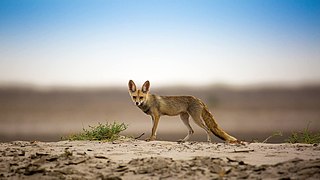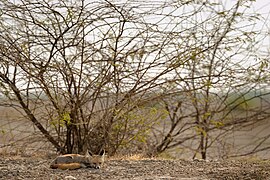| White-footed fox | |
|---|---|

| |
| An Indian desert fox or white-footed fox from Little Rann of Kutch, Gujarat, India | |
| Scientific classification | |
| Domain: | Eukaryota |
| Kingdom: | Animalia |
| Phylum: | Chordata |
| Class: | Mammalia |
| Order: | Carnivora |
| Family: | Canidae |
| Genus: | Vulpes |
| Species: | V. vulpes |
| Subspecies: | V. v. pusilla |
| Trinomial name | |
| Vulpes vulpes pusilla Blyth, 1854 | |
| Synonyms | |
|
leucopus (Blyth, 1854) | |
The white-footed fox (Vulpes vulpes pusilla), also known as the desert fox, is a small, Asiatic subspecies of red fox which occurs throughout most of northwestern Indian subcontinent, Pakistan's desert districts from Rawalpindi to Rajasthan and Kutch in India, Baluchistan, southern Iran, and Iraq. It is mostly found on sand-hills or in the broad sandy beds of semi-dry rivers, and only very rarely in fields, and then in the vicinity of sandy tracts.
Description
Like the Turkmenian fox, the white-footed fox has a primitive, infantile skull compared to those of its northern cousins. It is smaller than the Afghan red fox and Hill foxes, and never exhibits a red phase in its winter coat, nor the silvery, hoary phase of the Afghan red fox. It closely resembles the unrelated Bengal fox in size, but is distinguished by its longer tail and hind feet. As adults, their pelts are easily distinguished from other subspecies by the presence of a very distinct pale patch on each sides of the back behind the shoulders, which is overlapped by a dark, transverse stripe over the shoulders in front of the light patches. The colour on the back varies from brownish yellow to rusty red with slight admixture of white, while the flanks are whitish or greyish. The outer surface of the limbs are iron-grey or rufous, while the inner side of the forelegs and the whole front of the hind legs are white. The face is rufous, with dark markings around the eyes. The underparts are slaty in hue. The chin and the centre of the chest is white. The ear-tips are black or dark brown and paler at the base, lined with whitish hairs. The tail is almost the same colour as the back, but is less rufous on the sides and beneath. Most of the tail's hairs are black, and may form a dark ring at the end of the tail. The tip is white.
Behavior
It is similar in habits to the hill fox, but its diet is more carnivorous than that of other subspecies, and its prey is more restricted to gerbils and sand rats, due to the more barren habitat it occupies.
Gallery
-
 White-footed fox's skull
White-footed fox's skull
-

-
 Desert Habitat
Desert Habitat
-
 Typical habitat
Typical habitat
-
 Desert Fox Female in its Habitat
Desert Fox Female in its Habitat
-
 Mother and young
Mother and young
-
 Pups at den
Pups at den
-
 A pup mock hunting
A pup mock hunting
-
 Desert fox pups suckling
Desert fox pups suckling
-
 Desert fox pups with their mother
Desert fox pups with their mother
-
 Fox family playing at Little Rann of Kutch
Fox family playing at Little Rann of Kutch
References
- Wozencraft, W. C. (2005). "Order Carnivora". In Wilson, D. E.; Reeder, D. M. (eds.). Mammal Species of the World: A Taxonomic and Geographic Reference (3rd ed.). Johns Hopkins University Press. ISBN 978-0-8018-8221-0. OCLC 62265494.
- ^ Pocock 1941, pp. 123–4
- ^ Mivart 1890, pp. 124–25
- Heptner & Naumov 1998, p. 482
- Pocock 1941, p. 129
- Pocock 1941, p. 127
Works cited
- Heptner, V. G.; Naumov, N. P. (1998). Mammals of the Soviet Union Vol.II Part 1a, SIRENIA AND CARNIVORA (Sea cows; Wolves and Bears). Science Publishers, Inc. USA. ISBN 1-886106-81-9.
- Mivart, St. George Jackson (1890). Dogs, jackals, wolves, and foxes: a monograph of the Canidae. London: R.H. Porter.
- Pocock, R. I. (1941). "Fauna of British India: Mammals Volume 2". Taylor and Francis.
{{cite journal}}: Cite journal requires|journal=(help)
| Taxon identifiers | |
|---|---|
| Vulpes vulpes pusilla | |
This article about a carnivoran is a stub. You can help Misplaced Pages by expanding it. |